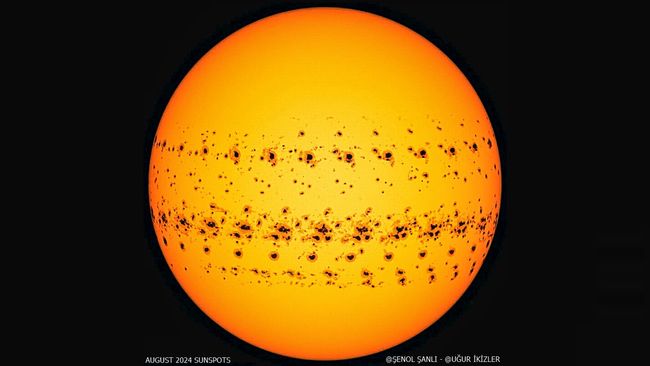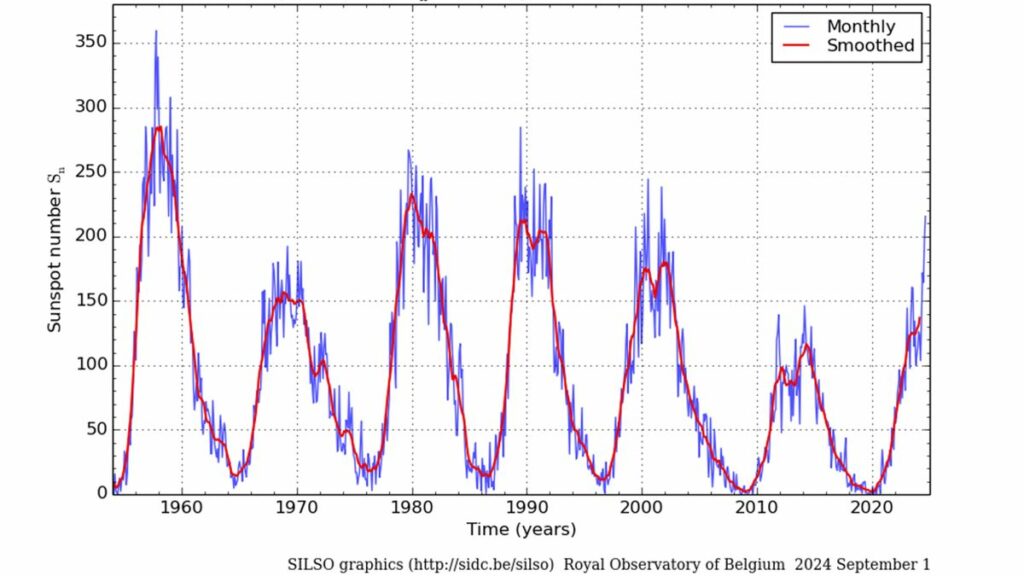Sunspots Reach 23-Year Peak as Solar Maximum Intensifies Beyond Predictions
The average number of visible dark patches on the sun’s surface in August was higher than any other month since September 2001. The final count was more than twice as high as experts initially predicted it would be.

New data says that the number of black spots in the sun’s surface in August has risen to the highest level ever recorded in 22 years. The most recent count of sunspots was over twice that of initial expectations, thus meaning that the sun’s flare up also referred to as the solar maximum is well advanced, and is more forceful than initially estimated.
Sunspots are relatively dark areas on the surface of our star that results from the emergence of concentrated bursts of electromagnetic radiation via the star’s magnetic field, and their seemingly black appearance is an illusion. These sunspots with show frequency as well as the intensity of the solar flares and coronal mass ejections depict the progression of the sun’s about 11 year solar cycle.
In the solar minimum, which is the sun’s least active period, there is little or no sunspots. For example, starting with the end of the previous cycle in the late of 2019 and the beginning of the current cycle 25, there were 40 days in which no sunspots were observed. While the sun’s magnetic field grows complex and increasingly feeble, the number of sunspots increases rapidly, and reaches a maximum during the period of solar maximum. This active phase goes on and ends with the magnetic field of the sun reversing and consequently, there is reduction in solar activity alongside the number of sunspots until another cycle begins.
The Space Weather Prediction Center SWPC, which is run by the National Oceanic and Atmospheric Administration and the National Weather Service documented an average of 215. Average sunspots: The average sunspots recorded in the occurrence of this phenomenon on the sun’s surface is 5 sunspots for a single day. The last time the monthly sunspot number was this high was in September 2001, at the peak of Solar Cycle 23 and the average was 238. 2.
The sun was most active on August eighth, when a total of 337 spots were counted — just one part per thousand of the star’s surface — the highest count of sunspots recorded over the past month and, in fact, the highest count for any single 24 hour period since March, 2001.
The above data indicate that the solar maximum may have started, but we will only be able to be certain when sunspots start to fade.

When the present solar cycle started in 2020, a group of SWPC scientists estimated low solar activity during Solar Cycle 25 similar to Solar Cycle 24 that occurred around 2014, was the weakest maximum in nearly nine decades. For example, the average of sunspots expected in August of the year 2024 was 107. 8, which is far much less than the actual percentage that has been observed in the recent past.
It also predicted that the solar maxima might not happen until 2025 at the earliest according to SWPC.
Nonetheless at the early instance of this cycle, the numbers that applied to sunspots were higher than the expected rates. They began to increase early this year 2022, hit their highest level since 2014 at the end of year, 2022. The average Sunspot number for June 2023 breached even the highest totals recorded in Solar Cycle 24 and it has been on the rise ever since.

hence in October, the SWPC released what it termed as a ‘revised forecast’, suggesting that Solar Cycle 25 would have a maximum by mid-2024 and be more active than earlier predicted.
But as can be seen from previous figures, indications are that we are at solar maximum not from rising sun spots only. For example, in early May the Earth saw the most powerful geomagnetic storm within over 21 years, which, painting the wide area of the Earth’s sky, filled it with auroras. Only a few days later, our sun released an X8. 7 magnitude solar flare — this is one of the strongest solar explosions occurring in the last 3 years.
Solar maximums can last for one to two years or more so there is a great possibility of higher sun activity in the next one year. In the SC 23, relative sunspot means reached their highest level of 244 per month. Daily value had 3 in July 2000 and the monthly record of Solar Cycle 22 was 284. 5 in June 1989.
More severe solar storms than the current ones, equal to the category of the recent 1859 Carrington Event may disrupt terrestrial facilities, produce lights in the night sky at lower latitudes and definitely make satellites go out of control and return back to earth.
Do not forget to share your opinion with us to provide you with the best posts !



0 Comments